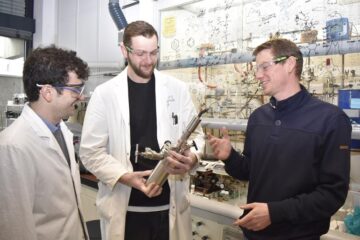Simulated Mars Mission Reveals Body’s Sodium Rhythms

Titze, now an associate professor of Medicine at Vanderbilt University, wanted to explore long-term sodium balance in humans. He didn’t believe the textbook view – that the salt we eat is rapidly excreted in urine to maintain relatively constant body sodium levels. The “Mars500” simulation gave him the chance to keep salt intake constant and monitor urine sodium levels in humans over a long period of time.
Now, in the Jan. 8 issue of Cell Metabolism, Titze and his colleagues report that – in contrast to the prevailing dogma – sodium levels fluctuate rhythmically with 7-day and monthly cycles. The findings, which demonstrate that sodium is stored in the body, have implications for blood pressure control, hypertension and salt-associated cardiovascular risk.
Titze’s interest in sodium balance was sparked by human space flight simulation studies he conducted in the 1990s that showed rhythmic variations in sodium urine excretion.
“It was so clear to me that sodium must be stored in the body, but no one wanted to hear about that because it was so different from the textbook view,” he said.
He and his team persisted with animal studies and demonstrated that the skin stores sodium and that the immune system regulates sodium release from the skin.
In 2005, planning began for Mars500 – a collaboration between Russia, the European Union and China to prepare for manned spaceflight to Mars. Mars500 was conducted at a research facility in Moscow between 2007 and 2011 in three phases: a 15-day phase to test the equipment, a 105-day phase, and a 520-day phase to simulate a full-length manned mission.
Crews of healthy male cosmonauts volunteered to live and work in an enclosed habitat of sealed interconnecting modules, as if they were on an international space station.
Titze and his colleagues organized the food for the mission and secured commitments from the participants to consume all of the food and to collect all urine each day. They studied twelve men: six for the full 105-day phase of the program, and six for the first 205 days of the 520-day phase.
“It was the participants’ stamina to precisely adhere to the daily menu plans and to accurately collect their urine for months that allowed scientific discovery,” Titze said.
The researchers found that nearly all (95 percent) of the ingested salt was excreted in the urine, but not on a daily basis. Instead, at constant salt intake, sodium excretion fluctuated with a weekly rhythm, resulting in sodium storage. The levels of the hormones aldosterone (a regulator of sodium excretion) and cortisol (no known major role in sodium balance) also fluctuated weekly.
Changes in total body sodium levels fluctuated on monthly and longer cycles, Titze said. Sodium storage on this longer cycle was independent of salt intake and did not include weight gain, supporting the idea that sodium is stored without accompanying increases in water.
The findings suggest that current medical practice and studies that rely on 24-hour urine samples to determine salt intake are not accurate, he said.
“We understand now that there are 7-day and monthly sodium clocks that are ticking, so a one-day snapshot shouldn’t be used to determine salt intake.”
Using newly developed magnetic resonance imaging (MRI) technologies to view sodium, Titze and his colleagues have found that humans store sodium in skin (as they found in their animal studies) and in muscle.
The investigators suspect that genes related to the circadian “clock” genes, which regulate daily rhythms, may be involved in sodium storage and release.
“We find these long rhythms of sodium storage in the body particularly intriguing,” Titze said. “The observations open up entirely new avenues for research.”
The studies were supported by grants from the German Federal Ministry for Economics and Technology/DLR Forschung unter Weltraumbedingungen and the Interdisciplinary Center for Clinical Research at Friedrich-Alexander-University, Erlangen-Nürnberg, Germany. Food products were donated by a number of organizations.
Media Contact
More Information:
http://www.vanderbilt.eduAll latest news from the category: Health and Medicine
This subject area encompasses research and studies in the field of human medicine.
Among the wide-ranging list of topics covered here are anesthesiology, anatomy, surgery, human genetics, hygiene and environmental medicine, internal medicine, neurology, pharmacology, physiology, urology and dental medicine.
Newest articles

Lower dose of mpox vaccine is safe
… and generates six-week antibody response equivalent to standard regimen. Study highlights need for defined markers of mpox immunity to inform public health use. A dose-sparing intradermal mpox vaccination regimen…

Efficient, sustainable and cost-effective hybrid energy storage system for modern power grids
EU project HyFlow: Over three years of research, the consortium of the EU project HyFlow has successfully developed a highly efficient, sustainable, and cost-effective hybrid energy storage system (HESS) that…

Safer alternative for an explosive reaction
The chemical industry has been using a reaction with explosive chemicals for over 100 years – now Mülheim scientists have discovered a safer alternative. The Ritter Group of the Max…





















